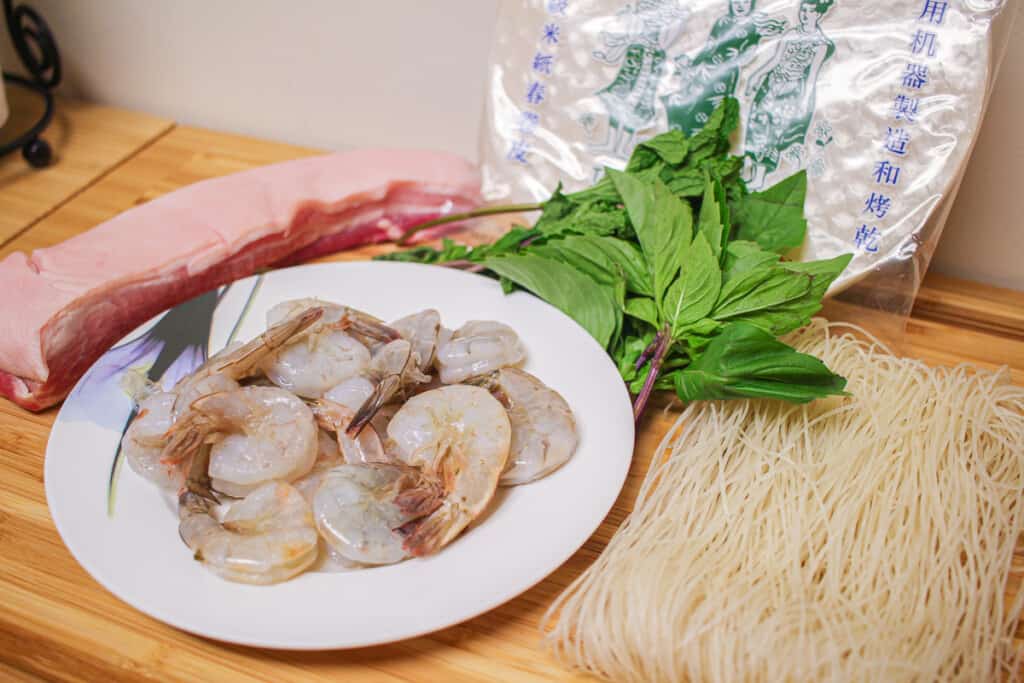Vietnamese gỏi cuốn tôm thịt are one of my favorite appetizers. You’ll find these pork and shrimp spring rolls at practically every Vietnamese restaurant. I love munching on the fresh, herbaceous rolls dipped in a creamy peanut sauce. However, restaurants usually only give you two spring rolls, and I’m very picky about the ratio of meats to noodles and vegetables. Gỏi cuốn is super easy to make at home. Here, you can control what ingredients go in your spring rolls. Plus, this recipe makes 15-20 spring rolls – a real bargain!
Pin Vietnamese Pork And Shrimp Spring Rolls To Try Later!
You might see these rolls listed on menus as summer rolls. And then there’s also the egg roll! So what’s the difference between spring rolls vs egg rolls vs summer rolls? Some sites say that spring rolls are made with a flour based wrapper and fried, whereas summer rolls are made with a rice paper wrapper and not fried. The egg roll is a variant of spring rolls with extra egg added to the wrapper. For the purposes of this blog, I will only be using the phrase spring roll to mean fresh rolls wrapped in rice paper (Gỏi Cuốn) and egg rolls for fried rolls wrapped in a flour based wrapper (Chả Giò)

Jump to:
- ? Ingredients
- ? Instructions
- ? Tips and substitutions
- ? Serving suggestions
- ? How to store or make in advance
- ? Serving size
- ? Recipe
? Ingredients
You will need:
For the gỏi cuốn
- 1 pack of rice vermicelli
- 1 lb (453g) pork belly
- 1 small shallot (about 15g, but it doesn’t need to be exact)
- 1 lb (453g) shrimp (I used easy peel, deveined shrimp)
- 1 head lettuce (you can use green or red leaf lettuce, or romaine)
- An assortment of herbs and vegetables (I used mint and thai basil. You could also add bean sprouts, chives and carrots)
For the peanut sauce
- 1 tablespoon neutral oil
- ½ tablespoon minced garlic
- ½ tablespoon minced shallot
- ½ cup (120g) smooth peanut butter
- ½ cup (128g) hoisin sauce
- 1 cup reserved pork belly cooking liquid
- sambal oelek chili sauce (optional)
? Instructions

Preparing the fillings
Cook the vermicelli according to the package’s instructions. Drain and rinse the noodles and set aside to cool.
Wash and dry all of the herbs and vegetables you plan on using.
Meanwhile, add the pork belly and a peeled shallot to a pot of boiling water and cook for about 20 minutes, or until a fork/chopstick easily pierces the meat and the liquid coming out of it runs clear.

Remove the pork belly to cool but keep the cooking liquid. Slice the pork belly thinly.

Add 1 tablespoon water to a small saucepan or pan and cook the shrimp on medium high heat until the shrimp are pink and no longer translucent. Let them cool before peeling them and slicing them in half.

Making the peanut sauce

In a small saucepan, sauté the minced garlic and shallot in a tablespoon of oil on medium heat.

Add the peanut butter, hoisin sauce, and reserved pork cooking liquid and stir until smooth.
If you want a spicy peanut sauce, add a tablespoon or two of sambal oelek to taste.
Assembling the spring rolls
Start by dipping a sheet of rice paper into a bowl of warm water QUICKLY. It’s likely the rice paper will still feel stiff in your hands. It will continue to soften as you assemble the fillings. Do NOT submerge the rice paper in water until it is soft, as it will fall apart by the time you are ready to roll.

I like to use the Three Ladies Brand rice paper. You can find it at most Asian grocery stores.
For gỏi cuốn, you could add the fillings in any order you want, but generally you want the shrimp to show up on the outside of the spring rolls on one side and the lettuce to show up on the other, with the noodles tucked in the middle.

To do this, start by layering the shrimp cut side up, followed by the pork belly, then herbs, then noodles, followed lastly by the lettuce.
I like to start with my fillings on the bottom and roll upwards. My family starts at the top and rolls downwards. In any case, you want to roll the fillings as snugly as possible once around, then fold the two sides of the rice paper towards the middle. Then roll the fillings all the way to the other end of the rice paper.
You can see a video of me rolling a spring roll in action here:
Serve the spring rolls with the peanut dipping sauce. You can add some crushed peanuts to the sauce for extra crunch.

? Tips and substitutions
I cannot stress enough how you should NOT submerge the rice paper sheet in water until it is soft. Your rice paper should still feel a little stiff when you are starting out. Take your time layering the ingredients and by the time you are ready to roll the paper will have softened enough to roll. The number one reason for a broken/exploded spring roll is using too much water to moisten the rice paper.
If you are an expert gỏi cuốn wrapper, you could put the shrimp cut side up above the rest of the ingredients so that it is nestled underneath fewer layers of rice paper after rolling. This makes the shrimp pop more, but there’s a higher chance of your spring roll ripping. See the photo below for how to set up the spring roll fillings in this way:

If you don’t want to cook and peel your own shrimp, you can buy precooked steamed shrimp instead.
? Serving suggestions
This is often served as an appetizer at Vietnamese banquets. I usually pack 4-5 of these as a quick and healthy lunch. It’s a good alternative to a typical lunch salad or sandwich!

? How to store or make in advance
Gỏi cuốn tôm thịt, like all rolls using rice paper, is best eaten as soon as it is made. The longer you leave them out, the more the rice paper will dry out and harden. If you’re making these in bulk for a party, you can wrap each spring roll individually in plastic wrap to prevent them from drying out. They should be eaten within 24 hours of rolling.
I like to prep all of my fillings at the beginning of the week and roll them as I go so they stay fresh.
? Serving size
This recipe makes 15-20 spring rolls depending on how much filling you stuff each roll with. For an appetizer, serve 2 rolls per person. As a meal, serve 4-6 rolls per person.
? Recipe
Did you make this recipe? Please tag @BunBoBaeBlog on Instagram or leave a rating or comment on the blog!
Loved this recipe? You might also like:

